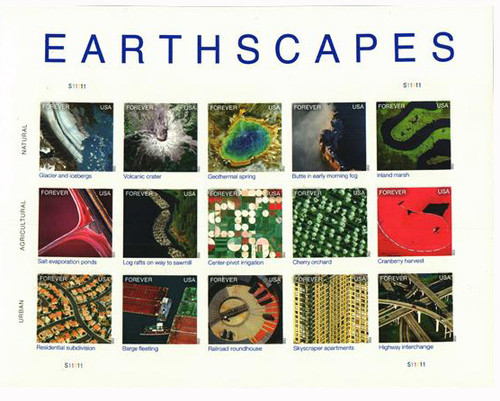
2012 First-Class Forever Stamp,Earthscapes: Cranberry Harvest
# 4710j - 2012 First-Class Forever Stamp - Earthscapes: Cranberry Harvest
$2.25 - $3.75
U.S. #4710j
2012 45¢ Cranberry Harvest
Earthscapes
2012 45¢ Cranberry Harvest
Earthscapes
Issue Date: October 1, 2012
City: Washington, DC
City: Washington, DC
Quantity: 2,670,000
Printed By: Banknote Corporation of America, Sennett Security Products
Printing Method: Offset
Perforations: Die Cut 10 ¾
Color: multicolored
The crisp autumn winds blow over the flooded cranberry bogs of Cape Cod, Massachusetts. Workers in their wading boots are knee-deep in cold water, harvesting the deep-red berries.
Native Americans introduced the early English settlers to the sour food which the Pilgrims called “bearberries” because bears enjoyed them as well. The Indians used cranberries for pemmican (a concentrated mixture of meat, fat, and berries), wound medicine, and dye. The English served them at their Thanksgiving feasts. After the Revolutionary War, veteran Henry Hall was the first to farm cranberries on Cape Cod in the early 1800s.
Cranberry vines grow in moist, acidic soil known as bogs. The bogs are flooded for harvest, usually from September through November. Water reels, or “eggbeaters,” loosen the berries from the vines, and the fruit floats to the top. They are corralled to a corner of the bog, loaded on trucks, and then sent to be processed.
Cranberry sauce has become as much a part of American Thanksgiving meals as the turkey. Many families open a can of jellied berries, but some start with fresh fruit and follow a time-tested recipe. The U.S. produced 681 million pounds of cranberries in 2011, and about 20% were eaten at Thanksgiving.
U.S. #4710j
2012 45¢ Cranberry Harvest
Earthscapes
2012 45¢ Cranberry Harvest
Earthscapes
Issue Date: October 1, 2012
City: Washington, DC
City: Washington, DC
Quantity: 2,670,000
Printed By: Banknote Corporation of America, Sennett Security Products
Printing Method: Offset
Perforations: Die Cut 10 ¾
Color: multicolored
The crisp autumn winds blow over the flooded cranberry bogs of Cape Cod, Massachusetts. Workers in their wading boots are knee-deep in cold water, harvesting the deep-red berries.
Native Americans introduced the early English settlers to the sour food which the Pilgrims called “bearberries” because bears enjoyed them as well. The Indians used cranberries for pemmican (a concentrated mixture of meat, fat, and berries), wound medicine, and dye. The English served them at their Thanksgiving feasts. After the Revolutionary War, veteran Henry Hall was the first to farm cranberries on Cape Cod in the early 1800s.
Cranberry vines grow in moist, acidic soil known as bogs. The bogs are flooded for harvest, usually from September through November. Water reels, or “eggbeaters,” loosen the berries from the vines, and the fruit floats to the top. They are corralled to a corner of the bog, loaded on trucks, and then sent to be processed.
Cranberry sauce has become as much a part of American Thanksgiving meals as the turkey. Many families open a can of jellied berries, but some start with fresh fruit and follow a time-tested recipe. The U.S. produced 681 million pounds of cranberries in 2011, and about 20% were eaten at Thanksgiving.









